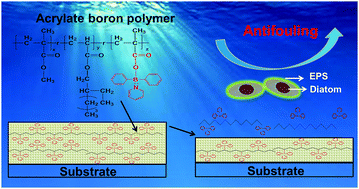Antifouling behavior of self-renewal acrylate boron polymers with pyridine-diphenylborane side chains†
Abstract
Currently, most high-performance tributyltin (TBT)-free antifouling paints contain cuprous oxide (Cu2O) in their formulations, leading to a serious challenge to the marine environment and ecosystem. In this study, non-metal acrylate boron polymers (ABPs) were synthesized using acrylate acid polymers (AAPs) as the backbone and a pyridine-phenyl borane compound as the side chain with hydrolyzable functional groups. The antifouling mechanism of ABPs researched by XPS and EDS indicated that the antifouling performance of ABPs was realized by the hydrolysis of hydrophobic diphenyl borane pyridine side groups. The results of diatom anti-setting test showed that fewer or no algae cells were attached on the surfaces of ABPs with higher contents of hydrophobic diphenyl borane pyridine side groups. The growth rates of algae suspension solutions containing ABPs were close to that of the blank solution without ABPs. Antifouling paints made of ABPs showed excellent antifouling performances in the Yellow Sea of China. This study provides new insights into the development of ABPs with desirable antifouling properties and environmental friendliness.



 Please wait while we load your content...
Please wait while we load your content...